|
This and the following pages describe the webmaster's involvement
with the production of The Truth Behind the Moon Landings from
Zig Zag
Productions. The webmaster participated in only one segment of
the program.
THE SET
The goal of this segment was to attempt to duplicate some aspects
of the lunar environment using Hollywood techniques in order to show
some important factors in lighting and photography.
The location selected was an area of the Mojave Desert that is
popular with filmmakers seeking otherworldly landscapes. The
wilderness preserve adjacent to the Trona Pinnacles has been used in
Star Trek V and in Tim Burton's Planet of the Apes. It
was chosen for its lack of vegetation and its soil mix of dust and
rocks that was presumed to approximate many aspects of the lunar
surface.
The filming was done at night, so that sunlight would not
intrude. The lighting was provided by a single 18 kW studio light
placed so that it would illuminate a patch of ground 150-200 feet
(50-70 meters) away. At that distance the light rays -- while not
exactly parallel -- are close enough that the error in shadow "lie" on
the surface is less than the "noise" created by the irregular
ground[1].
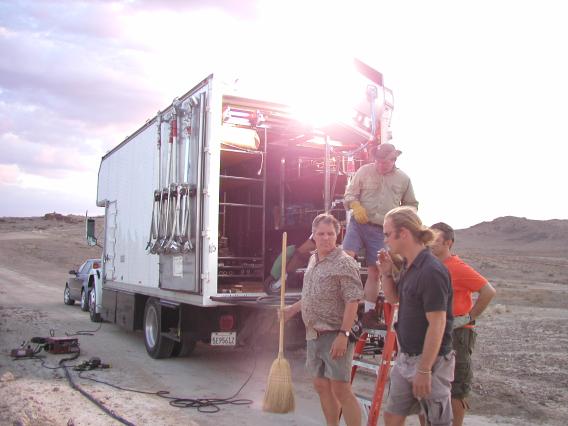
|
|
Fig. 1 -The grip truck is set up with the 18 kW arc light
on its lift. The grips have set the light to be at an elevation of
about 9° as seen from the set. (Zig Zag Productions
and Clavius)
|
|
|
Fig. 1 shows the lighting setup. The light is on the truck's lift
so that its elevation relative to the ground can be adjusted to
simulate different lighting angles.
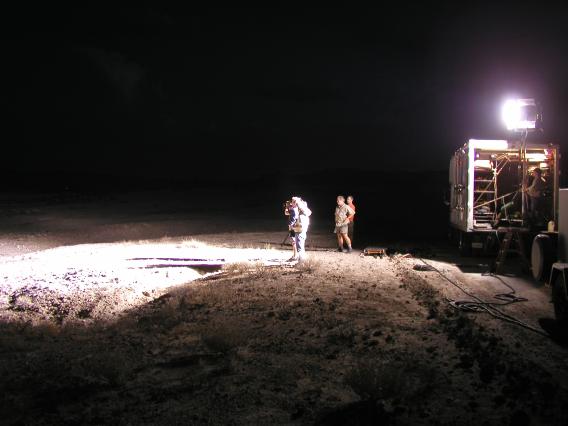
|
|
Fig. 2 -The grip truck and light after sundown.
The studio light is the only light source for this
photograph. The patch of illuminated ground in the left of the
photo is not where the photography occurred; the photos were taken
on a slight rise out of frame to the left. (Zig Zag Productions
and Clavius)
|
|
|
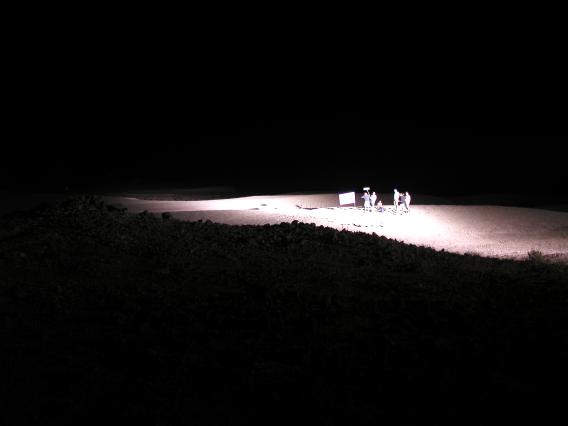
|
|
Fig. 3 -The moon set in the California desert as seen
from a distance. The light is well out of frame to the right.
(Zig Zag Productions and Clavius)
|
|
|
In Fig. 2 the sun has gone down and the light is properly
focused. That one light is the only light source for the scene. The
first thing we notice is that the side of the truck is visible.
According to the conspiracists, that side of the truck shouldn't be
receiving any light at all. But it's being lit by the spill from the
brightly lit ground on which the crew is walking.
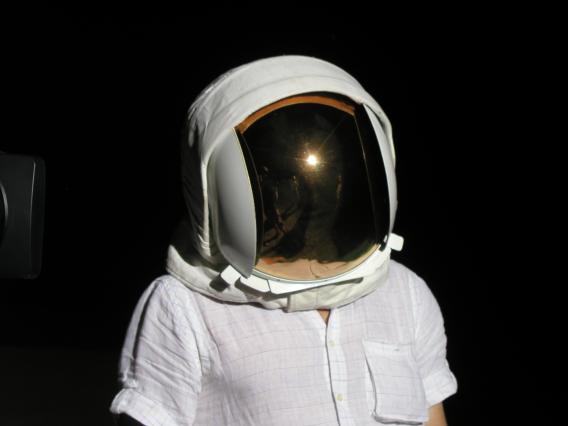
|
|
Fig. 4 -Producer Lorne Townend wears a replica Apollo
space helmet. Note the reflections of standers-by in the visor.
(Zig Zag Productions and Clavius)
|
|
|
This is our first evidence that the conspiracists' claims are
incorrect when they state that the shaded sides of objects should be
pitch black with only one light source.
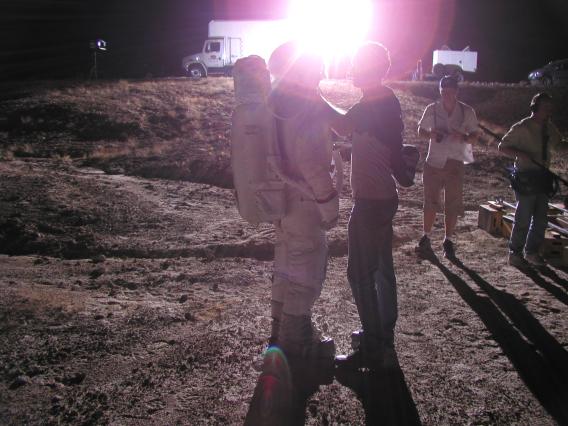
|
|
Fig. 5 -A crewman prepares the astronaut-actor in a
replica Apollo space suit. An additional light has been placed to
light the truck, since it will be part of this shot. That light is
not present in Fig. 2.
(Zig Zag Productions and Clavius)
|
|
|
In Fig. 5 the photo is taken directly into the light source. Yet
we are able to see the shaded side of the astronaut. In fact, we are
able to see the shaded side of all the participants. Only the blue
jeans of the space suit specialist have lost detail. Some of the
light is being reflected up from the ground below us, and some of it
is coming from the photographer himself, who is standing in the
light.
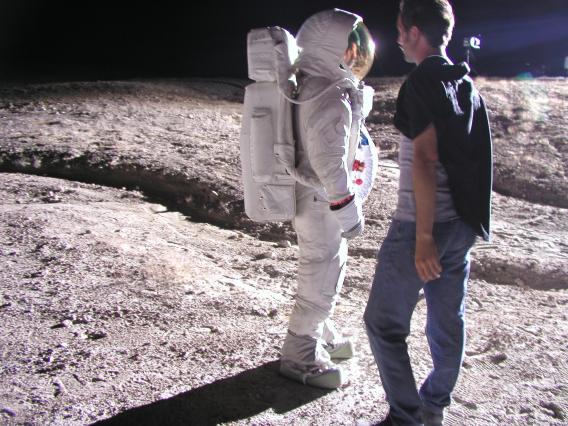
|
|
Fig. 6 -The astronaut is lit solely by a single distant
studio light, but remains visible.
(Zig Zag Productions and Clavius)
|
|
|
Fig. 6 is a photo taken with more appropriate exposure settings.
Here the photographer has "opened up" the shadows by slightly
overexposing the frame. This is a standard technique that all
photographers learn. Note how the shadows and shade lines created by
the primary light are sharp lines. Note also how the shadows created
by the fill lighting from the ground are soft.
The same effects can be seen in Fig. 7, in which the camera is
rolling. Most revealing is the dolly grip's orange shirt. His back
is well lit, but the tops of his shoulders are still mostly shaded,
revealing that the light is coming from below.
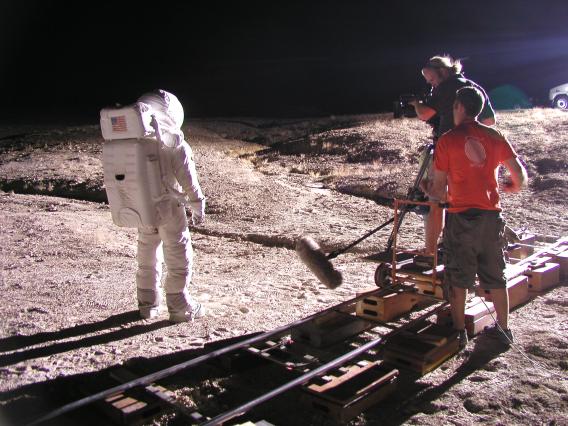
|
|
Fig. 7 -The astronaut is filmed in the reproduced lunar
environment. He remains quite visible, even given the singular
light source.
(Zig Zag Productions and Clavius)
|
|
|
This is consistent with Buzz Aldrin's appearance in Fig. 8, where
he is lit primarily from below by light from the lunar surface.
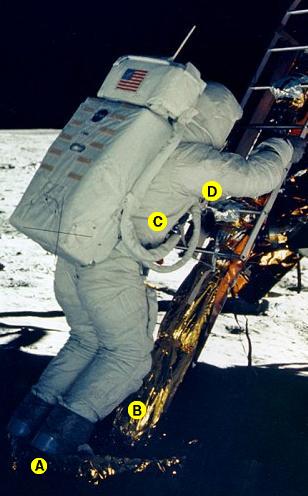
|
|
Fig. 8 -Buzz Aldrin at the foot of the lunar module's
ladder. The tops of his shoulders are dark (D) indicating that the
light is coming from below. (NASA: AS11-40-5869, annotations by
Clavius)
|
|
|
Another important aspect to note in these photographs is the
continuing starkness of the astronaut-actor's shadow on the ground.
Even though the suit is well lit from spill off the surface, the
shadow itself remains pitch black. This is fully consistent with
optics, as demonstrated and explained by the webmaster in the program.
Shaded objects receive indirect light from nearby sunlit objects that
they face. But the surface itself does not typically face any
directly lit objects and so receives no indirect or direct light in
shadow.
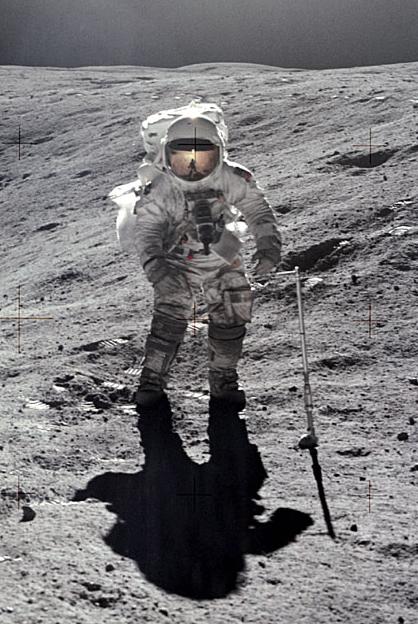
|
|
Fig. 9 -Apollo 16 lunar module pilot Charlie Duke with
his back to the sun. Conspiracists say this photo is impossible
because the shaded side of the astronaut (the side facing us) is not
directly lit by the sun. However we have shown that this photograph
is fully consistent with the principles of single-light
photography. (NASA: AS16-114-18423 detail, annotations by
Clavius)
|
|
|
Conspiracists say Fig. 9 is impossible as a sunlit photograph
because the astronaut's shaded side is visible, and they say it should
be completely dark. We've shown that this expectation is unfounded.
 Don't you realize you've
just proven that the anomalous photographs in question could have been
-- and probably were -- taken with artificial light? Don't you realize you've
just proven that the anomalous photographs in question could have been
-- and probably were -- taken with artificial light?
That is not the point here. The conspiracists claim that these
photographs are impossible without supplementary light (i.e.,
"fill" light in lighting terms) requiring multiple light sources.
They say they cannot be produced with a single light source, which
would have been the case had they really been on the moon -- the
single light source being the sun. But this experiment proves that a
single directional light source can produce the appropriate
diffuse interreflections for the Apollo photography, contrary to the
conspiracy theory's claims. In this particular experiment, it doesn't
matter whether the light source is artificial or natural. It's only
important that the light source be directional, fairly distant, and
the only light source.
The conspiracists' objection to this experiment isn't based on
science. They haven't shown what specific aspect of the artificiality
of the light source defeats the experiment. They can only make vague,
handwaving arguments about the "artificial" light source and hope that
generates enough uncertainty and doubt to undermine its credibility
with the layman.
But in fact the experiment shows how little the conspiracists
actually know about lighting and photography. They perform no
experiments. They simply show example photographs under what they
claim are identical conditions (but ignore aspects such as photo
exposure), or simply provide edited versions of the photos that show
what they believe should have happened. That's not proof; it's just
an elaborately stated opinion that happens to be wrong.
NOTES
- At a distance of 200 feet the angular error in lighting direction
per transverse foot is 0.29°. That is negligible for most of the
camera angles used in the reconstruction. Once a light source is
sufficiently far away, it behaves more like an infinitely distant
light than a nearby light.


| 















 Don't you realize you've
just proven that the anomalous photographs in question could have been
-- and probably were -- taken with artificial light?
Don't you realize you've
just proven that the anomalous photographs in question could have been
-- and probably were -- taken with artificial light?
